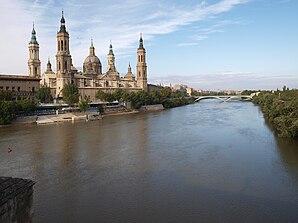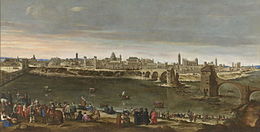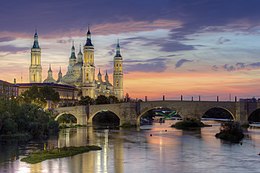Zaragoza
| Zaragoza municipality | ||
|---|---|---|
 Saragossa - El Pilar Basilica on the Ebro
|
||
| coat of arms | Map of Spain | |

|
|
|
| Basic data | ||
| Autonomous Community : | Aragon | |
| Province : | Zaragoza | |
| Coordinates | 41 ° 39 ′ N , 0 ° 54 ′ W | |
| Height : | 243 msnm | |
| Area : | 973.78 km² | |
| Residents : | 674,997 (Jan 1, 2019) | |
| Population density : | 693.17 inh / km² | |
| Postal code : | 50001-50020 | |
| Municipality number ( INE ): | 50297 | |
| administration | ||
| Website : | Zaragoza | |
Saragossa ( Spanish: Zaragoza ) is the capital of the Spanish autonomous community of Aragon and the province of Saragossa with a population of 674,997 (as of January 1, 2019) . The symbol of Zaragoza is the Basílica del Pilar . The 2008 Expo took place in Saragossa .
Location and climate
The city of Saragossa is located at the confluence of the Río Huerva in the Ebro at an altitude of around 240 m . The climate is temperate to warm; Rain (approx. 355 mm / year) falls over the year.
| Zaragoza | ||||||||||||||||||||||||||||||||||||||||||||||||
|---|---|---|---|---|---|---|---|---|---|---|---|---|---|---|---|---|---|---|---|---|---|---|---|---|---|---|---|---|---|---|---|---|---|---|---|---|---|---|---|---|---|---|---|---|---|---|---|---|
| Climate diagram | ||||||||||||||||||||||||||||||||||||||||||||||||
| ||||||||||||||||||||||||||||||||||||||||||||||||
|
Average monthly temperatures and rainfall for Zaragoza
Source:
|
|||||||||||||||||||||||||||||||||||||||||||||||||||||||||||||||||||||||||||||||||||||||||||||||||||||||||
Population development
| year | 1857 | 1900 | 1950 | 2000 | 2017 |
| Residents | 63,399 | 99.118 | 264.256 | 604.629 | 664.938 |
The mechanization of agriculture , the abandonment of small farms and the associated loss of jobs led to an enormous increase in the population as early as the 19th century.
economy
The most important company for the economy of Zaragoza is the Opel plant , which opened in November 1982 and is located 30 kilometers northwest in Figueruelas. The Groupe PSA plant employs 6500 people. Numerous supplier companies have settled around the factory in which the Opel Corsa , Opel Mokka , Opel Crossland X and Citroën C3 Aircross models are produced. There are also two BSH Hausgeräte plants (BSH Electrodomésticos España SA, Fábrica Montañana / La Cartuja), the railway manufacturer CAF ( Construcciones y Auxiliar de Ferrocarriles ), the paper manufacturer SAICA (Sociedad Anónima Industrias Celulosa Aragonesa), ICT Ibérica and Torraspapel and the , the chocolate manufacturer Lacasa and Hispano Carrocera (in cooperation with Tata Motors ) with important production facilities in and around Saragossa.
traffic
The airport of Zaragoza is served by the Irish low-cost airline Ryanair , which maintains a so-called base there. At the moment (2018), however, there are no flights to and from Germany. From June 2019 the Spanish low-cost airline Volotea plans to offer flights from Munich. The airport with the IATA code ZAZ is the civil part of a military airfield, which was also intended as a European emergency landing port for the space shuttles .
The city is one of the most important railway hubs in Spain. She's in the Railway - high-speed traffic on the routes Madrid-Barcelona and Zaragoza-Huesca connected. Mostly the Velaro E of the ICE 3 group is driving at 300 km / h. The provincial capitals Huesca and Teruel are within easy reach of Saragossa .
For the Expo 2008 in Saragossa an S-Bahn-like local transport ( Trenes de cercanías ) was set up, which, like the long-distance trains in the urban area of Saragossa, runs underground, and runs from Casetas via Delicias Central Station and the former El Portillo Central Station to Miraflores in the southeast of the city. Since 2011, parts of a tram between the districts of Actur in the north and Casablanca in the south have been completed. In order not to interfere with overhead lines in the city center, the train runs there with batteries that are recharged at each station for the next section of the route.
history



The city was built between 24 and 12 BC. Founded by the Romans under the name Colonia Caesaraugusta . The current name Zaragoza goes back to this Latin name - via the Arabic intermediate level Saraqusṭa . The Synod of Zaragoza took place in 380 AD .
In 452 the city was conquered by Germanic Suebi and in 466 incorporated into their empire by the Visigoths . In 541 there was a siege by the Franks , which they could not take. In the Visigothic period, especially in the 7th century, Saragossa became a center of cultural prosperity through some of the city's bishops, especially Braulio of Saragossa and Samuel Tajón .
In the 8th century, North African Muslims succeeded in conquering the city. Since then the city has belonged to the emirate , since the 10th century to the Caliphate of Cordoba and was an outpost in the fight against the Christian kingdoms in northern Spain. After the caliphate collapsed into the Taifa kingdoms , the Tujibids set up their own business in Saragossa, but they were soon replaced by the Hudids . The Almoravids conquered the city in 1110 , but as early as 1118 the Christian kingdom of Aragón under Alfonso I was able to conquer Saragossa from the Muslims and make it the new capital of the country. In 1348 the plague reached the Iberian Peninsula . With the onset of the plague, the anti-Jewish attitudes that already existed escalated; it escalated to the so-called plague pogroms against Spaniards of Jewish faith. Calatayud and Saragossa were the only cities in Spain without pogroms .
During the war of independence against Napoleon , Zaragoza was besieged from June 15 to August 13, 1808 without success. On December 21, 1808, another siege began on Saragossa, which ended on February 20, 1809 with the surrender of the city to the French troops.
On July 19, 1936, at the beginning of the Spanish Civil War , Miguel Cabanellas , the General Inspector of the Guardia Civil in Zaragoza, ordered the occupation of the strategic points of Zaragoza and the assassination of 360 leaders of the Popular Front parties. Among the liquidated was General Nuñez de Prado , who was loyal to the republic, and his adjutant. After 1200 requetés arrived from Pamplona , the nationalists occupied neighboring cities in which the nationalists had not been victorious.
After the nationalists came to power, the Republicans tried to take Zaragoza. On July 23, 1936, two columns left Barcelona for Saragossa. The anarchist Durruti led the first column . Major Pérez Farras commanded the second column . Neither column succeeded in taking Zaragoza for the Republicans. Between August and September 1937, the Republicans tried again to take Zaragoza during the Battle of Belchite . Not only would the capture of the city of Zaragoza have been a symbolic act for the Republicans, but Zaragoza was also the communications center for nationalists in the region. By bringing in nationalist troops from Madrid, they were able to prevent Zaragoza from being captured by the Republicans. During the Civil War, 3543 Republicans are known to have been murdered in the Cementerio de Torrero cemetery; those murdered were between 13 and 84 years old. The last mass grave was found in 1979 on a back wall of the cemetery.
On December 16, 2004, the delegates of the Bureau International des Expositions in Paris decided that Zaragoza could host the Expo 2008 ( world exhibition ). Saragossa prevailed against Trieste and Thessaloniki . In 2011, Zaragoza was among the six Spanish shortlisted candidates for the title of European Capital of Culture 2016, which was ultimately awarded to Donostia-San Sebastián .
Culture and sights

The cityscape is a mixture between old and modern, in the city center is the old town ( casco viejo ). As in some Spanish cities, the historic city center is noticeably deteriorating, as many Zaragoza residents have moved from the city center to more modern residential complexes on the outskirts. At the weekend, the city center with its numerous bars is very popular with tourists.
At the northern end of the old town is the city's landmark, the Basílica del Pilar . It is the largest baroque building in Spain, built in honor of the Virgin Mary . In it stands a pillar (span. El pilar ) on which the Virgin Mary is said to have appeared to the Apostle James. In front of the building is an impressive square, the Plaza del Pilar . Right next to it is the five-aisled late Gothic Catedral de la Seo, the oldest church in Zaragoza.
The city's largest festival is also held in honor of Our Lady on the Pillar . The festival attracts visitors from all over Spain and culminates on October 12th, which is also Spain's national holiday. In an impressive ceremony, flower carpets and flower arrangements are laid in honor of the Virgin Mary on the square in front of the Basílica del Pilar .
After the Basilica del Pilar, the Aljafería Palace is also impressive. It was built in the 11th century on the orders of Abū Jaʿfar Ahmad I ibn Sulaimān ibn Hūd , Muqtadir, (ruled from 1046 to 1081/1082), the Moorish dynasty of the Banu Hūd and bears his name: (Qasr) al-Jaʿfariyya. Later it was used by the kings of Aragon and expanded with richly decorated rooms from 1488. A barracks was later set up here. Today it is used as the seat of the regional parliament of Aragon and as a museum. The Aljafería is the only extensively preserved Moorish building in Saragossa. The French orientalist Pierre Guichard believes that the Christian conquest of Zaragoza saved the palace from destruction by subsequent Moorish dynasties.
Not far from the Basilica del Pilar is the stock exchange ( La Lonja ), a hipped-roofed block built between 1541 and 1551 under Gil Morlanes and Juan de Sariñena, the interior of which forms a high hall in which slender Renaissance pillars support a late Gothic ribbed vault. The market hall was built on the old city wall in 1909 in the style of historicism. Interesting are the many still-used caves in the Juslibol district in the north and a wetland called Galalcho de Juslibol in an old arm of the Ebro .
The Plaza de Toros de Zaragoza , built in 1764, is the second oldest bullring in Spain.
Sports
Soccer
The city founded Real Saragossa in 1932, an internationally known football club. The club was able to win a European cup twice : in 1995 the European Cup Winners' Cup and in 1964 the Fair Cup , a forerunner of today's Europa League . Real Zaragoza has won the Spanish national cup competition six times . In the past, the club played mostly in the Primera División , the highest Spanish division, but has since been relegated to the second division , to which they have been part since 2013. The club's venue is the Estadio La Romareda , which is located quite centrally on the outskirts of the city center and has a capacity of almost 35,000 spectators. Three preliminary round games were played there at the 1982 World Cup , and the stadium was also the venue for several football games as part of the 1992 Summer Olympics in Barcelona .
Town twinning
Zaragoza is twinned with:
-
 Pau , Nouvelle-Aquitaine region, France
Pau , Nouvelle-Aquitaine region, France -
 Biarritz , Nouvelle-Aquitaine region, France
Biarritz , Nouvelle-Aquitaine region, France -
 Zaragoza , Guatemala
Zaragoza , Guatemala -
 La Plata , Argentina, since 1990
La Plata , Argentina, since 1990 -
 Leon , Nicaragua
Leon , Nicaragua -
 Bethlehem , Palestine
Bethlehem , Palestine
-
 Tijuana , Mexico
Tijuana , Mexico -
 Móstoles , Spain
Móstoles , Spain -
 Ponce , Puerto Rico
Ponce , Puerto Rico -
 Coimbra , Portugal
Coimbra , Portugal
There are special cooperation agreements with Toulouse in France, Mostar in Bosnia-Herzegovina, Tirana in Albania, Yulin in China and Ploieşti in Romania. Saragossa is also a member of the Union of European Napoleonic Cities .
sons and daughters of the town
- Ibn Baddscha (around 1095 – around 1138), philosopher and universal scholar
- Abraham Abulafia (1240–1291 / 92), Kabbalist and mystic
- Elisabeth of Portugal (1271–1336), Princess of Aragon and Queen of Portugal
- Sebastián Aguilera de Heredia (1561–1627), organist and composer
- Francisco Ballesteros (1770-1832), General
- Roberto Prádez y Gautier (1772–1836), artist and teacher for the deaf and mute
- José de Palafox y Melci (1775–1847), general and defender of Zaragoza during the Napoleonic Wars
- Agustina de Aragón (1786–1857), freedom fighter in the Napoleonic Wars
- Feliciano Gascon (1859–1920), guitarist and pianist
- Paquita Escribano (around 1890 – around 1970), singer
- Amparo Poch y Gascón (1902–1968), medic, publicist, anarchist and syndicalist
- Plácido Domingo Ferrer (1907–1987), Zarzuela singer (baritone)
- Ángel Sanz Briz (1910–1980), diplomat, Righteous Among the Nations
- Fernando Sancho (1916–1990), actor
- Pilar Lorengar (1928–1996), soprano
- José Luis Borau (1929–2012), film director
- Inés Ayala Sender (* 1957), politician
- Juan Antonio San Epifanio (born 1959), basketball player
- Fernando Simón (* 1963), epidemiologist
- Fernando de Felipe (* 1965), comic book and screenwriter
- Enrique Bunbury (* 1967), rock singer
- Pablo Alfaro (* 1969), football player
- Mark Consuelos (born 1971), actor
- David Cañada García (1975-2016), racing cyclist
- Luis Carlos Cuartero (* 1975), football player
- José Miguel Elías (* 1977), racing cyclist
- Rubén Gracia Calmache (* 1981), football player
- Marc Langebeck (* 1982), event presenter, television presenter and actor
- Diego Domínguez (* 1991), actor, dancer and singer
- Jesús Vallejo (born 1997), football player
Other events:
- The rock band Héroes del Silencio was founded in Saragossa in 1984.
- The band Amaral was founded in 1997 in Saragossa.
literature
- Emil Huebner : Caesaraugusta . In: Paulys Realencyclopadie der classischen Antiquity Science (RE). Volume III, 1, Stuttgart 1897, Col. 1287 f. (to the ancient Caesaraugusta).
Web links
Individual evidence
- ↑ Cifras oficiales de población resultantes de la revisión del Padrón municipal a 1 de enero . Population statistics from the Instituto Nacional de Estadística (population update).
- ↑ Zaragoza - climate tables
- ^ World Weather Information Service. Retrieved July 16, 2019 .
- ^ Zaragoza - population development
- ^ Dietmar Hawranek: Dismantling West, Construction East. Der Spiegel March 26, 2012, p. 81
- ↑ https://www.volotea.com/en/flight-offers/munich/zaragoza/
- ↑ Guía de Zaragoza ó sea breve noticia de las antigüedades, establecimientos públicos, oficinas y edificios que contiene, precedida de una ligera reseña histórica de la misma . Imp. De Vicente Andrés, 1860 ( google.es [accessed March 20, 2018]).
- ↑ a b DiCom Medios SL: Gran Enciclopedia Aragonesa Online. Retrieved March 20, 2018 (Spanish).
- ↑ Antony Beevor: The Spanish Civil War , 2nd edition, ISBN 978-3-442-15492-0 , page 92
- ^ Hugh Thomas : The Spanish Civil War , Ullstein Verlag, Berlin West 1962, page 190
- ↑ Leo Wieland : Europe's gift for the Bildu Basques. In: FAZ , July 3, 2011; Europe's Capitals of Culture 2016: San Sebastián and Wroclaw. In: Euractiv , August 12, 2011; both accessed on October 18, 2019.
- ^ Cities twinned with Zaragoza. Zaragoza City Hall . Ayuntamiento de Zaragoza. Retrieved January 4, 2015.




